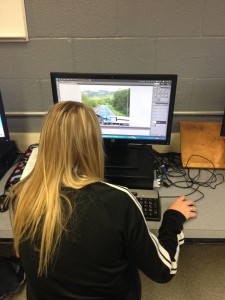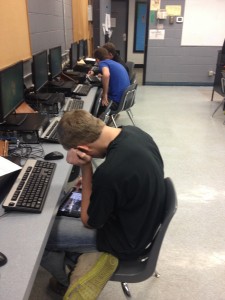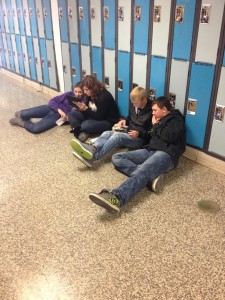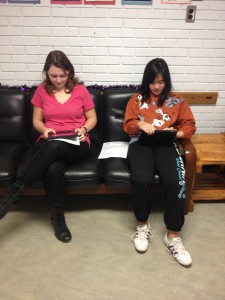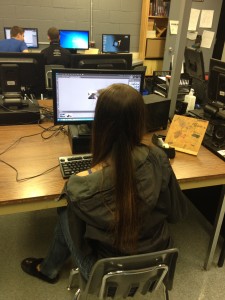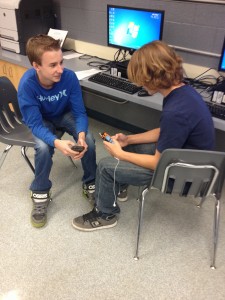As a final post for my major digital project, I wanted to include a sample of student work. I was really impressed with the quality of work they were able to create. While we did encounter some bumps along the road, the project was a success, as it was a learning experience for everyone involved (see Copyright? Copyleft?). One of the things I learned as I was trying to include samples of student work on my blog is the importance of having students upload their videos to a video hosting site such as You Tube or vimeo. One group was not able to enter the contest due to copyright concerns, and so I tried to upload this video directly into this post. The file size exceeded the maximum allowed, and Sue Waters informed me that I would need to embed it from a video hosting site. In previous posts, I have embedded videos from You Tube with no problem. The video that is included here is entered in the contest (vote now!), and it was uploaded to vimeo.
Category Archives: Final Project
Contest Entrance Day!
Today is the day I have anxiously been awaiting… Entries for the Just Drive! Canada contest are due. I have been working with an enthusiastic group of Grade 10 students in the creation of advertisements that warn against the dangers of distracted driving. Most students created images, a few groups created videos, and one brave young lady wrote and performed her own song. Each entry had to be reviewed by the admissions committee, and if accepted will be placed on the website for the voting phase. The voting phase takes place from November 14th- December 13th, and during that time students are encouraged to use social media and other forms of communication to gather votes for their advertisements. The top 10 advertisements after the voting phase move on to the judging phase where judges will determine the top finisher and the runner-up. The Just Drive! contest is active on social media, and the home page suggests that you follow them on Facebook, Twitter, Flickr, You Tube, and the Just Drive Canada blog.
Please visit Just Drive! and vote for our work. Unfortunately, there is not a really time efficient method of voting, only to scroll through and vote for any of our William Derby School entries.
Copyright? Copyleft?
I have heard of the term Copyright before, but honestly I had never given it too much thought. I was pretty sure that it was wrong to copy entire textbooks for students, and I knew that I should give credit to an image I used in a presentation, but that was about the extent of my knowledge on the subject. I remembered hearing about a recent Fair dealing agreement that changed the way Copyright is dealt with in Canada, but it has never been a subject in which I have incredibly knowledgeable.
I have always been good at referencing written work in traditional research papers, but giving attribution to a Creative Commons work?? This is new territory for me. Territory that is causing me a great deal of stress and anxiety! As I follow the dialogue that occurs about Copyright in EC&I 831 it seems to me that those in Higher Ed are much more conscientious about choosing images that are Copyright free, and providing attribution to those images correctly. I think it is part of the culture that exists in Higher Ed institutions. After all, we would never see a Copyright Officer in a middle school, and these issues are not forefront in what we do everyday. But, I do see the importance of choosing images and infographics that are not copyright, and attributing them properly. I also know the importance of teaching students that everything that is on the internet is not “free” for their taking (and use).
These things being said, Copyright issues proved to be a real problem for me in my final project. This project involved the creation of images, audio and video that warn against the dangers of distracted driving for the Just Drive! Canada contest. After all the stress about the technology, getting students motivated to work in Project-Based Learning, and monitoring student progress, I didn’t give appropriate thought to Copyright Issues. I did read through the contest rules and there was no mention of Copyright (what to do or not to do, how to choose images and sounds correctly). As we forged ahead with the project, many students took their own pictures to create their images, but some chose images off of a Google search, and edited them to create their final project. Most students who created videos were fine, because they were original productions starring only them.
When the time comes to enter the contest I immediately panicked when the first groups of students uploaded their images and were asked to tick off a box signifying that their image was “free of copyright” (or something to that affect). “Mrs. Sauer, what do we do here?”, “Mrs. Sauer, do we click this box?”, “Mrs. Sauer, is our image copyright?”. My heart sank and feelings of sadness and defeat came over me as I realized I had missed a very important part of this project. Copyright. Of course, being as resilient as students are, they weren’t too worried about it. I explained to them that if they were worried about copyright issues we would have to work together to figure it out or their creation couldn’t be entered in the contest. I know that this was and is a teachable moment- and I need to work with students to talk about Copyright and the fair and ethical use of information off the Internet at some point in the near future.
Have you dealt with Copyright issues in your classroom, or your own personal work before?
Do you always choose Creative Commons images and attribute them properly (no judgement here!)?
Students Hard at Work
Project-Based Learning
Well once again time got away from me, and it has been a week and a half since I reflected on my work with my Grade 10 students on our advertising campaign simulation.
For those of you who did not read my initial post, I am working with students to create advertisements that warn against the dangers of distracted driving. The advertisements will be submitted to the Just Drive! Contest sponsored by Allstate Insurance. I was fortunate to be able to work with our Division Learning Technologist Jim Swan on the project, and he brought with him a class set of iPads for our use (yes, we are one of the last remaining schools on the planet that does not have any iPads available for student use). He spent 2 classes with the students- one describing the project, and the second introducing students to the technology. Students were able to choose from creating an image, a song, or a video. The tools we chose to show were iMovie (link is to an 8 minute tutorial on iMovie for the iPad), Adobe PhotoShop Touch, and Garage Band. Students were given a quick lesson on each of the apps, and then asked to decide the direction they would take with the project.I chose to let students work alone or with a partner of their choice on this project. I made this decision with great deliberation, and I was quite pleased with the choices they made.
Students had 4 class periods to work independently on their projects. It never ceases to amaze me how much work these “independent” work periods are for the teachers. I seemed to be pulled in a million different directions and bombarded with questions each and every period. I kept trying to remind myself of the learning that was taking place.
I am always surprised at how exhausting yet rewarding Project-Based Learning can be! When I debriefed the project with Jim, we discussed how students need to be deprogrammed from their need to be so reliant on the teacher. Most students rely heavily on teachers to provide them with ideas, direction, and answers. Very few are what I would consider independent learners. I was amazed that students would wait 15 minutes to ask me a question, when their answer could have been found almost immediately with a quick Google search. I wondered to myself, when do we become independent learners? When I have a question, I find the answer myself, and I really want to work with my students to try and do the same. It is such a valuable life skill.
My question then is, how can we encourage our students to be more independent in their learning? How can we take the onus off of the teacher to be in control of the learning?
Reflections of the Early Stages
Well, my project got “off the ground” so to speak on Monday. Jim and I spent the first full period introducing the project, showing sample videos, and exploring the Just Drive! Canada website. We looked at last years winners and realized that this is something that is definitely within reach for our talented, enthusiastic group of Grade 10’s!
For some reason, I always have a bit of nerves when I introduce Project Based Learning– it seems like there is so much information to share, and there is such a delicate balance between giving students all of the information they need and not totally overwhelming them. I try to remind myself that students will figure things out as they go, and they are capable of great things without me directing them every step of the way. Jim helped to remind me of that. Essentially, I need to become more comfortable with relinquishing “control” over when and how students learn. I need to embrace the notion that students do not have to be taught to learn- something that I agree with wholeheartedly.
My reflections on the challenges of PBL relate closely to our session with Sylvia Martinez on “Invent to Learn- Making, Tinkering, and Engineering in the Classroom”. Sylvia is an active promoter of the importance of play and “tinkering” in learning, and her background in Science and Engineering was obvious as she maneuvered her way through various demonstrations with ease. Sylvia shares her “Thoughts about empowering students through technology” on her Generation YES Blog. There were three statements that Sylvia made that really stuck with me. They were:
– the importance of having students work to solve problems vs just giving them ready made knowledge
– that learning occurs when a new experience makes connections to existing knowledge
– to not be afraid to step out of your comfort zone if it can help a student’s learning experience; i.e. a teacher’s anxiety should not be a barrier to student’s learning
Sylvia also shared with us some “cool” tools that can be used to support the message behind invent to learn. She demonstrated both Makey Makey and Sparkfun Inventors Kit. Watching Sylvia confidently demonstrates the wonders of these things, I went back and forth between being totally in awe and being totally overwhelmed! As someone who has never been “into” tinkering and inventing things, this type of learning leaves me looking for the “right answer”. However, as she was playing with these amazing learning tools, I could see their potential in the classroom. I could pick out students from each of my classes who would totally excel at the type of learning Sylvia was showing. I must admit, I felt a bit sad as I realized that I do not give enough opportunities for making, tinkering, and engineering in my classroom. But, there is no time like the present, and it is never too late to try something new. One of my goals for this school year is to step out of comfort zone, ensuring that my anxiety doesn’t interfere with the learning opportunities of my students.
Are there things you shy away from because of your comfort level?
Are you always willing to try new things, or do you tend to stick with the tried and true?
Ready, Set, Begin Final Project
Today is the day. It is day one of my final project.
For my project, I have the opportunity to work with Jim Swan, Learning Technology Leader with Horizon School Division. After some discussion with Jim, I have decided to proceed with an ad campaign simulation that will tie into my Information Processing 10 course.
The scenario: The stats are in and texting and driving are killing 1 in 10 teen drivers and AllState has hired us to change this! You will be working in the field of advertising to create and manage an advertising campaign that highlights the dangers of distracted driving.
Very briefly, this project will involve:
Part 1: Introduce the importance of advertisements and social media in advertising using the Media Triangle, Montana Meth Project, and Advertising Techniques video
Part 2: Introduce the Letter from All-State that introduces the contest
Part 3: Discuss Evaluation of the Project
Part 4: Students get to work creating their advertisements in one of the four categories: video, sound, or image. They will have a chance to work with different software programs to create their ad. They will need to do the research and experimentation about how best to create the ad they have imagined.
Part 5: Students submit their ad to the Just Drive Canada contest
Part 6: Students will use social media and other forms of communication to gather votes for their ad. The winners of the contest are awarded cash individually as well as to their school.
I am hoping that students will embrace the creative process and really work to produce the best quality work possible. I am excited that I was able to choose a project that fits into my teaching, as well as forces students to address an issue that they will be dealing with in the near future (these students are 15, and most will be getting their driver’s licenses soon).
I would appreciate any comments on my project in it’s beginning stages. Positives? Negatives?

